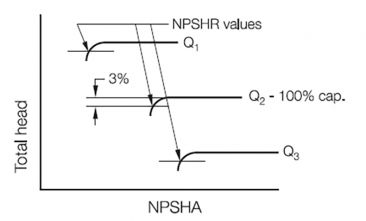
How is the net positive suction head required (NPSHr) determined for vertical pumps?
For rotodynamic pumps, it is customary to determine the NPSHr as the NPSHa where a 3% reduction in head occurs. It is then known as the NPSH3.
The NPSHr could be determined and stated by the manufacturer differently as the NPSHa that results in a specified performance, but again, is typically at the 3% head reduction.

The method for determining NPSHr does not change for vertical pumps, other than that the test setup in the laboratory will need to accommodate the vertical pump design.
The most common method is to run the pump at a constant rate of flow and speed, and then vary the suction head. As NPSHa is reduced, and the corresponding pump head is plotted, a point is reached where the head curve breaks away for a straight line trend (Image 2) indicating a deterioration in pump performance.
The 3% head drop illustrated in Image 1 is the standard to determine NPSHr. For multistage pumps, the 3% applies to the first stage head only.
This test is repeated at various flow rates. Image 2 shows the results typical of tests at flow rates both above and below pump design flow.
For more information on pump testing and how NPSH3 is determined, refer to HI Standard 14.6 Rotodynamic Pumps for Hydraulic Performance Acceptance Tests at www.pumps.org.

